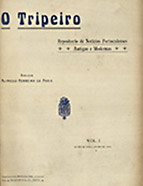

................................
In this vein, the summaries encompass a range of multifaceted writings, including legends and traditions, biographies of distinguished personalities, monuments, the press, institutions, theatre and bullfighting shows, key moments in city life, and more. Some of these were featured in dedicated sections throughout the issues, such as Portuenses d’hontem e d’hoje [People of Porto, Past and Present], Tipos populares do Porto [Popular Characters of Porto], O Porto descrito por estrangeiros [Porto Described by Foreigners], and O que dizem de nós [What They Say About Us]. Perhaps the most innovative section was Correspondência entre leitores [Correspondence Between Readers], which invited readers to pose questions or clarify facts and experiences. These were answered either by contributors or by other readers, fostering a dynamic and interactive dialogue. The adoption of a universal and inclusive cultural and scientific programme—while fundamentally focused on historical themes—was designed to appeal to a broad audience regardless of gender or intellectual background. The language was accessible and conversational, free from excessive erudition, and often complemented by engravings to enhance comprehension and engagement. From the outset, O Tripeiro identified its target audience as the citizens of Porto or their admirers, presenting itself as "more Porto than any other, disinterestedly patriotic." While its primary focus was on the city, the periodical also included notes and documents from neighbouring areas such as Gaia, Matosinhos, and Maia. This broadened its scope beyond Porto to embrace regional and even national interests. Given the breadth of its programme, it is challenging to summarise the main historiographical trends, debates, and historical themes it addressed. However, its content typically revolved around episodes and personalities from the city and the northern region, a focus that persisted throughout all six series of the periodical, with subsequent iterations remaining faithful to this original concept.
This work is financed by national funds through FCT - Foundation for Science and Technology, I.P, in the scope of the projects UIDB/04311/2020 and UIDP/04311/2020.
